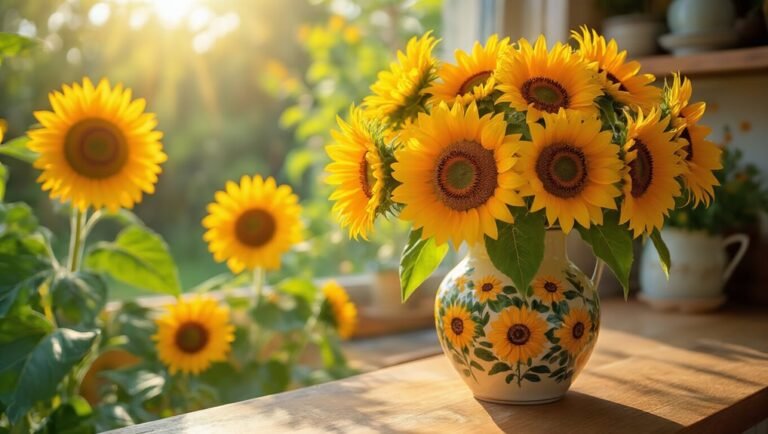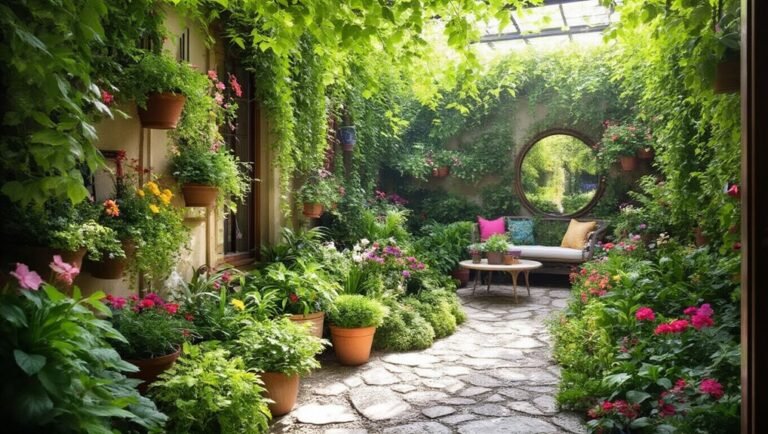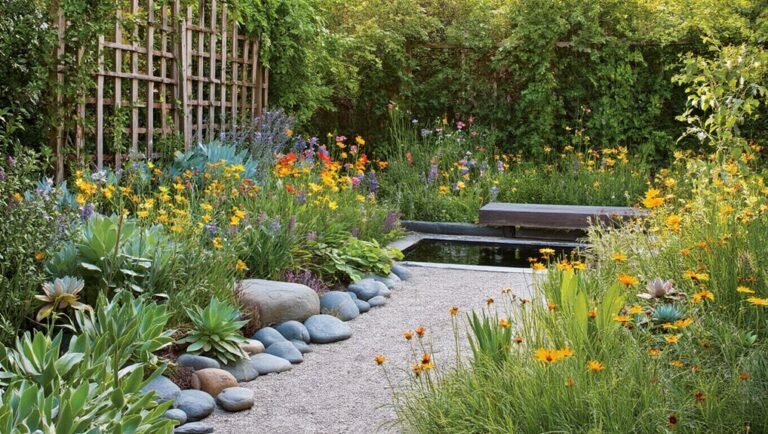To create stunning front-of-house flower beds, start by choosing plants that suit your local climate and soil type. Mix layers and textures by placing taller plants in the back and incorporating various foliage. Don’t forget to enhance your design with hardscape elements like trellises, edging, and pathways. These additions not only improve aesthetics but also functionality. Stick around, and you’ll discover more tips to elevate your flower beds even further.
Key Takeaways
- Choose a mix of native plants suited to your local climate and soil type for resilience and low maintenance.
- Incorporate layers and textures by placing taller plants at the back and varying foliage types for depth.
- Add hardscape elements like trellises and pathways to create structure and enhance navigation in your flower bed.
- Utilize organic mulch to retain moisture, suppress weeds, and improve soil quality while complementing garden aesthetics.
- Create visual interest by combining seasonal blooms, bold plants with delicate ones, and using unique plant pots for added appeal.
Choose the Right Plants for Your Climate and Soil
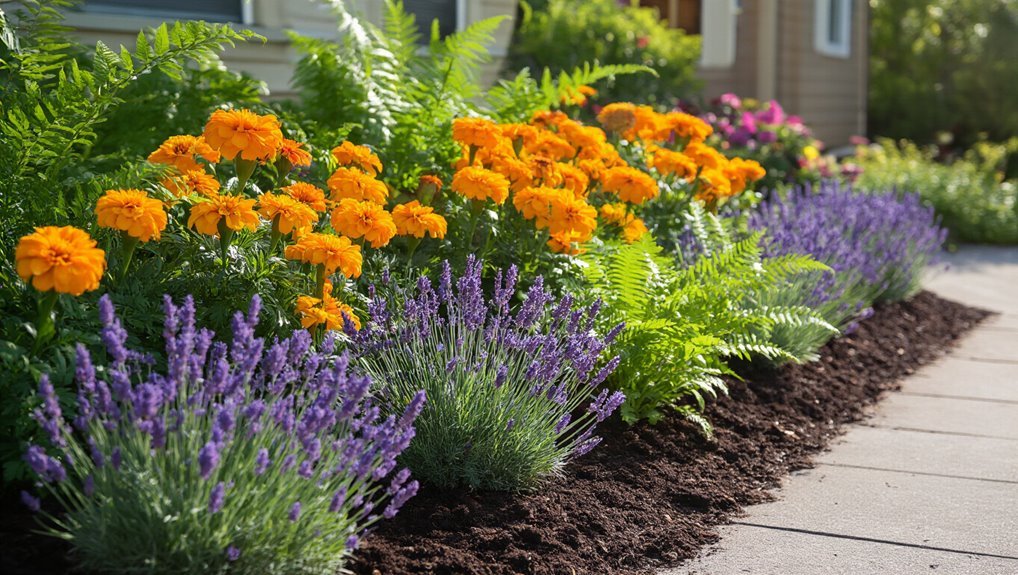
When choosing plants for your flower bed, it’s crucial to consider your climate and soil type, as these factors significantly influence plant health and growth.
Start by assessing your local climate—are you in a hot, dry area or a cooler, wetter region? This will guide you in selecting plants that thrive in your environment. Incorporating organic mulching materials like straw can also help moderate soil temperature and improve the overall growing conditions for your chosen plants.
Next, test your soil; determine its pH and drainage capabilities. Some plants prefer sandy soil, while others flourish in clay or loamy conditions.
Once you’ve gathered this information, choose plants that match your climate and soil. Native plants often require less maintenance and are more resilient.
Finally, don’t forget to consider the sunlight your flower bed receives, ensuring your chosen plants get the right amount for optimal growth.
For added plant health and a polished appearance, consider using mulch in your garden, as it helps retain moisture, suppress weeds, and improve soil quality.
Incorporate Layers and Textures for Visual Interest
Creating a visually appealing flower bed goes beyond just selecting the right plants; layering and texturing are key. By incorporating various heights and textures, you can create a dynamic and engaging space. Start with taller plants in the back, medium heights in the middle, and shorter ones in the front. Mixing foliage types, such as broad leaves with fine textures, adds depth and interest. Raised garden beds can help you achieve optimal soil depth and drainage while making it easier to organize your layers and textures.
| Plant Type | Texture |
|---|---|
| Sunflowers | Bold, Large |
| Ferns | Delicate, Fine |
| Lavender | Aromatic, Soft |
| Sedum | Succulent, Thick |
Consider seasonal changes too; use evergreens for year-round structure. For an added touch, you can also display your favorite blooms in beautiful plant pots to elevate the overall design of your front of house space. With thoughtful layering and texturing, your flower bed will captivate all who see it.
Add Hardscape Elements to Enhance Your Design
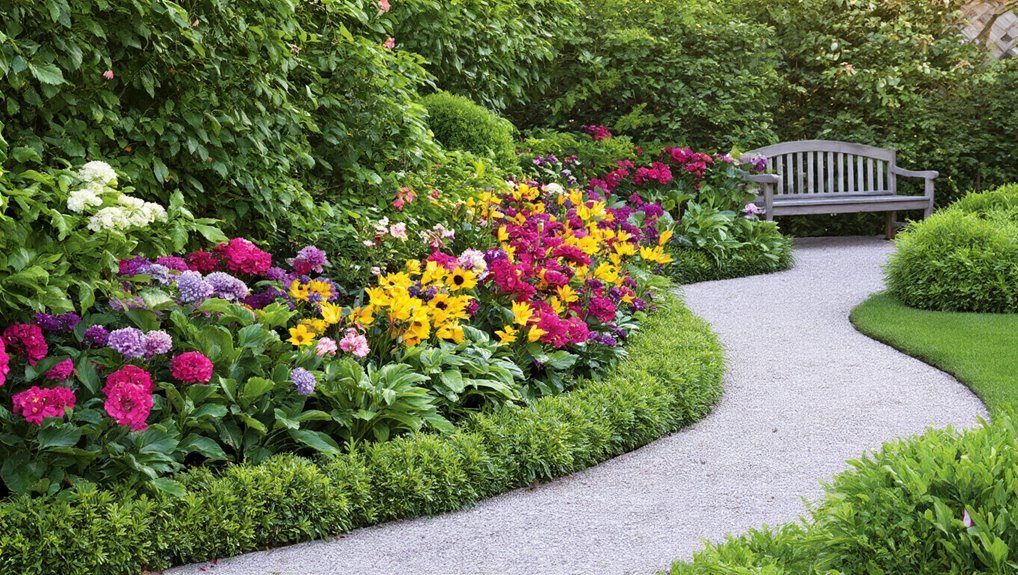
To elevate your flower bed design, consider adding hardscape elements that provide structure and contrast.
These features not only enhance the visual appeal but also improve functionality. Integrating garden trellises into your landscape can support climbing flowers while creating beautiful vertical accents.
Here are some ideas to incorporate:
- Edging: Use brick, stone, or metal to define the boundaries of your flower bed, creating a clean look.
- Pathways: Add stepping stones or gravel paths that lead through your flower bed, making it easy to navigate.
- Raised Beds: Construct raised flower beds for better drainage and a more dynamic height variation.
- Decorative Fencing: Install decorative fencing or trellises that can support climbing plants and add vertical interest.
For the most precise and professional results, consider using edging tools specifically designed to create clean, defined lines around your flower beds.
Frequently Asked Questions
How Often Should I Water My Flower Bed?
You might think daily watering’s best, but it’s not. Instead, check the soil; if it’s dry an inch down, water deeply once or twice a week. Your flowers’ll thrive with this routine!
What Are the Best Tools for Flower Bed Maintenance?
For flower bed maintenance, you’ll want to invest in a sturdy trowel, pruners, a rake, and a hoe. These tools help you cultivate, prune, and maintain healthy plants, ensuring your flower bed thrives beautifully.
How Can I Attract Pollinators to My Flower Bed?
Imagine your garden as a lively dance floor. To attract pollinators, plant native flowers, avoid pesticides, and create diverse blooms. Their vibrant arrival will turn your flower bed into a buzzing celebration of nature’s beauty.
When Is the Best Time to Plant Flowers?
The best time to plant flowers depends on your climate. Generally, wait until after the last frost in spring. If you’re in a warmer area, you can often start planting as early as late winter.
How Do I Deal With Pests in My Flower Bed?
To deal with pests in your flower bed, regularly inspect your plants for signs of trouble. Use organic pesticides, introduce beneficial insects like ladybugs, and maintain plant health to naturally deter unwanted visitors.
Conclusion
You might think creating a stunning flower bed is too complicated or time-consuming, but it doesn’t have to be! By choosing the right plants for your climate, layering textures, and adding hardscape elements, you can effortlessly enhance your front of house. Remember, it’s all about finding the right balance and letting your creativity shine. You’ll be amazed at how a little planning can lead to a beautiful, welcoming space that adds curb appeal and joy to your home.
